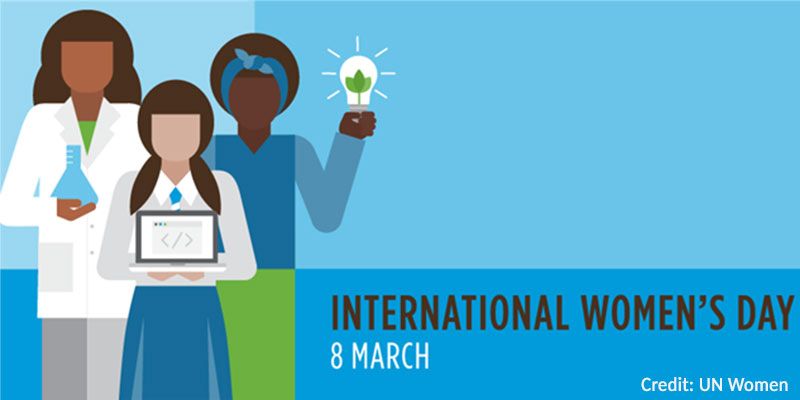- India
- Mar 08
- Sreesha V.M
International Women’s Day
• International Women’s Day, celebrated globally on March 8, is a day to honour the achievements of women across all spheres of life.
• This year’s theme is “For ALL Women and Girls: Rights. Equality. Empowerment”.
• In 2025, the theme emphasizes the need for equal rights, power, and opportunities for all women and girls, ensuring an inclusive future where no one is left behind.
• This year is particularly significant as it marks the 30th anniversary of the ‘Beijing Declaration and Platform for Action’, a landmark document that has shaped the global agenda for women’s rights.
Indian govt’s programmes for women empowerment
• In India, the government has been actively working towards women’s empowerment and gender equality through various policies, schemes, and legislative measures.
• The country is transitioning from women’s development to women-led development, ensuring equal participation in national progress. Women are breaking barriers in education, health, digital inclusion, and leadership roles, shaping India’s socio-economic landscape.
Constitutional and Legal Framework
The Indian Constitution guarantees gender equality through:
• Article 14: Equality before the law.
• Article 15: Prohibition of discrimination based on sex.
• Article 51(a)(e): Encourages citizens to renounce practices derogatory to women’s dignity.
• Directive Principles (Articles 39 and 42): Emphasize equal livelihood opportunities, equal pay, and maternity relief.
India is a signatory to international treaties such as:
• Universal Declaration of Human Rights (1948)
• International Covenant on Civil and Political Rights (ICCPR, 1966)
• Convention on the Elimination of All Forms of Discrimination Against Women (CEDAW, 1979)
• Beijing Declaration and Platform for Action (1995)
• United Nations Convention Against Corruption (2003)
• Agenda 2030 for Sustainable Development.
Schemes for women’s upliftment
1) Education
• Beti Bachao Beti Padhao (BBBP): Promotes girls’ education.
• Samagra Shiksha Abhiyan: Supports school infrastructure.
• National Education Policy (NEP) 2020: Prioritises gender equity.
• Vigyan Jyoti: Encourages girls in STEM fields.
• Female Gross Enrollment Ratio (GER): Surpassed male GER in 2017-18.
2) Health and Nutrition
• Pradhan Mantri Matru Vandana Yojana (PMMVY): Provides cash incentives to pregnant and lactating mothers.
• Maternal Mortality Rate (MMR): Reduced from 130 (2014-16) to 97 (2018-20).
• Jal Jeevan Mission: Provides potable tap water to 15.4 crore households.
• Poshan Abhiyaan: Strengthens maternal and child nutrition programmes.
3) Economic Empowerment
• PM Jan Dhan Yojana: Over 30.46 crore accounts (55 per cent women).
• Stand-Up India Scheme: 84 per cent of loans sanctioned to women entrepreneurs.
• MUDRA Scheme: 69 per cent of micro loans given to women-led enterprises.
• Self-Help Groups (SHGs): 10 crore women connected to 9 million SHGs.
4) Digital and Technological Empowerment
• PMGDISHA: 60 million rural citizens trained in digital literacy.
• Common Service Centres (CSCs): 67,000 women entrepreneurs running digital service centers.
• Ayushman Bharat Digital Mission (ABDM): Bridging healthcare accessibility.
• SANKALP Hubs for Women Empowerment: Functioning in 742 districts across 35 states/UTs.
Key Legal Frameworks
• Criminal Law (Amendment) Act, 2018: Enhanced penalties for crimes against women.
• Protection of Women from Domestic Violence Act, 2005.
• Sexual Harassment of Women at Workplace Act, 2013.
• POCSO Act, 2012: Strengthened laws against child abuse.
• Ban on Triple Talaq (2019): Criminalising instant divorce practices.
• Dowry Prohibition Act, 1961: Penalises dowry-related offences.
• Prohibition of Child Marriage Act, 2006: Protects minors from forced marriages.
Key Achievements
• Women in STEM: 42.57 per cent of total Science, Technology, Engineering, and Mathematics (STEM) enrolment.
• Women in Armed Forces: Entry into NDA, combat roles, and Sainik Schools.
• Civil Aviation: Over 15 per cent women pilots, higher than the global average of 5 per cent.
• Financial Inclusion: Over 30.46 crore Jan Dhan accounts (55 per cent women).
• Digital Literacy: 60 million rural citizens trained under PMGDISHA.
(The author is a trainer for Civil Services aspirants.)

